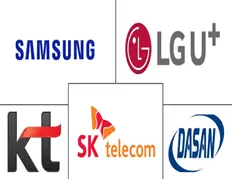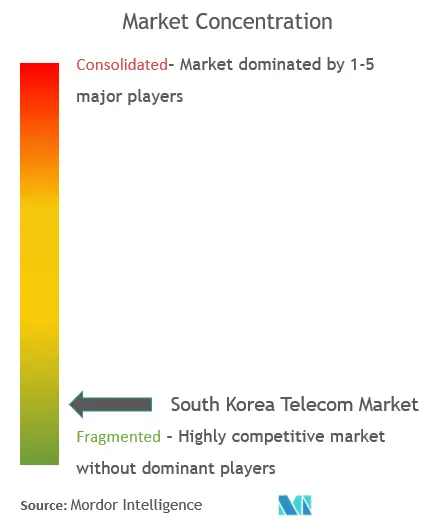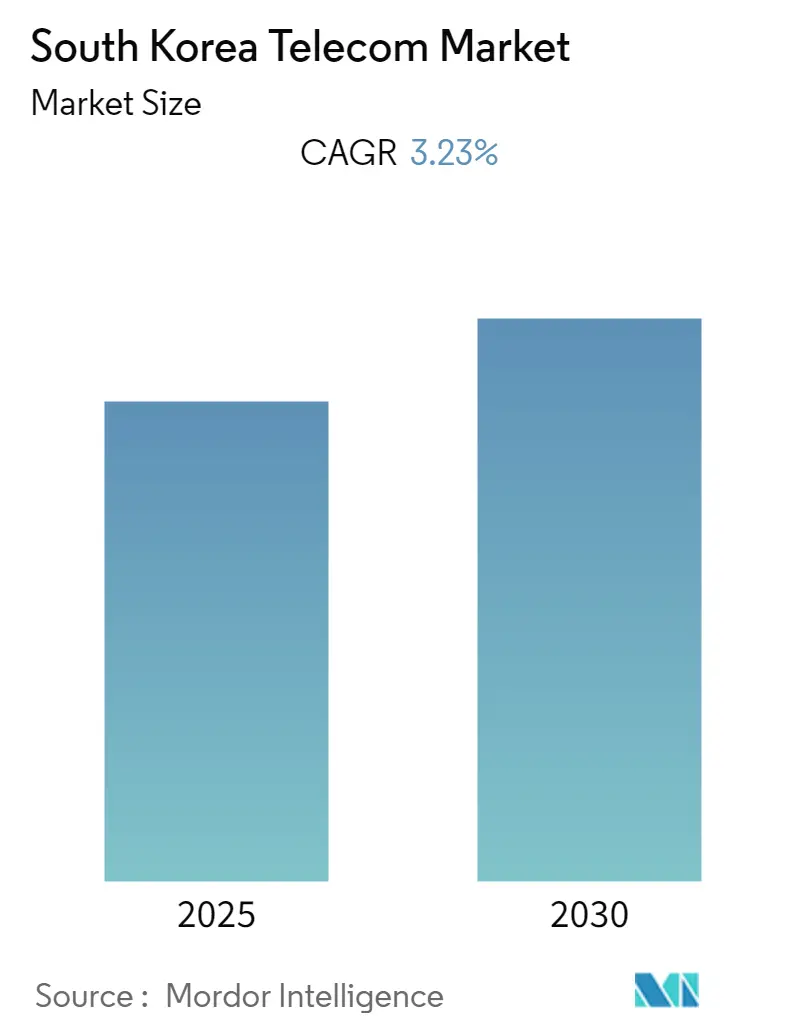
South Korea Telecom Market Analysis
The South Korea Telecom Market is expected to register a CAGR of 3.23% during the forecast period.
- South Korean 5G receives great accolades in terms of speed and coverage. According to data from the Ministry of Science and ICT, there are close to 24 million 5G customers in South Korea. SK Telecom, the largest cellular carrier in South Korea, came first internationally in terms of download speed for 5G networks. Meanwhile, the third-largest mobile provider in the nation, LG Uplus, came in second with 429.6 Mbps, followed by Tele2 AB of Sweden, KT Corp. of South Korea, Bulgaria's Vivacom Inc., and LG Uplus.
- The South Korean government has long been confident in becoming the global leader in 5G. Since the launch, the South Korean government's support for 5G has only increased. According to a report from Business Today, the South Korean government allocated WON 165 billion (USD 140 million) to expand 5G coverage across the nation last year. Since the initial stage of the 5G rollout, South Korea's 5G ecosystem has brought together government ministries, legislative bodies, carriers, private sector vendors, research institutes, and other players like trade unions and civil society organizations.
- In South Korea, fiber internet is practically universal, mobile penetration is high, and many companies have already embraced 5G services. Due to this, despite rising corporate demand for high-bandwidth services to assist cloud migration, the ability of operators to increase income from core communications services is constrained. However, major South Korean operators reported significant enterprise revenue growth and have high growth goals for the coming years. Telecom operators are partnering with IT experts and public cloud service providers to accomplish these aims. These developments are anticipated to drive their market share in ICT, create new services for local enterprises, and extend their operations globally.
- The COVID-19 pandemic significantly impacted the South Korean telecom sector. Lockdowns and strict social segregation laws gave businesses a task and a chance to modify their organization for remote work while developing innovation that might fulfill South Korea's quickly evolving telecommunications demands. When COVID-19 initially broke out in South Korea in early 2020, SK Telecom and other market-leading firms were in charge of the country's transition to the new generation of wireless network technology. Telecommunications remained an essential service during this period as many people sought to upgrade their services and plan to suit a transition to working and studying from home. During this time, most telecom firms in South Korea accelerated digital transformation and expected competitiveness and workforce resilience as the benefit of these transformations.
South Korea Telecom Market Trends
Incredible Availability and Speed of 5G
- South Korea became the first country to provide 5G networks commercially. Presently, 85 of its cities already have 5G services. The introduction of new handsets, notably Apple's new iPhone series, has led to an increase in 5G users nationwide, according to reports from RCR Wireless. As per the report, SK Telecom, the nation's largest mobile operator by subscriptions, had 11.4 million 5G subscribers at the end of the current year, followed by KT with 7.3 million and LG Uplus with 5.2 million.
- Currently, South Korea is the world leader in 5G speed, showing early success in scaling a domestic network and developing an all-encompassing national plan to use the revolutionary potential of 5G fully. The nation's experience demonstrates the government's importance as a crucial enabler for developing the 5G ecosystem, especially in countries with a developed mobile sector. The government employed an open process to develop the next-generation mobile network and offered a clear strategic direction.
- The 5G Impact on the Global Mobile Network Experience study from Open Signal ranked South Korea at number one globally for 5G download speed, with customers reporting download rates of 438 Mbps. South Korea was also rated top globally for 5G reach and availability. The study revealed that South Korean consumers not only had a 5G connection in two-thirds of the places they went but also spent nearly one-third (30.7%) of their time with an active 5G connection.
- Encouragingly, South Korea also has the best 5G voice application experiences, while the nation also tops the charts for 5G gaming. According to a current industry assessment, SK Telecom, the largest cellular carrier in South Korea, scored first internationally for 5G network download speeds. The average download speed across SK Telecom's 5G network was 469.6 megabits per second (Mbps), 2.55 times faster than the 184.2 Mbps average across all worldwide mobile carriers, according to the global mobile industry tracker Opensignal. With 429.6 Mbps, LG Uplus, the third-largest mobile carrier in the nation, came in second, ahead of Vivacom Inc. of Bulgaria, Tele2 AB of Sweden, and KT Corp. of South Korea.
- South Korea is frequently seen as a bellwether for 5G, in part because the nation's regulatory body tracks the technology's uptake in detail. According to Omdia research notes, there were 24.53 million 5G customers in South Korea as of August 2022, making up almost 33% of all mobile subscriptions in the country. More significantly, nearly 70% of the nation's mobile data traffic is currently being carried by 5G networks. That is mainly because the typical 5G user utilizes around 27 GB per month, or over 3.1 times the average 4G user. All these findings depict that South Korea is way ahead of other network providers across the globe in terms of the 5G network.
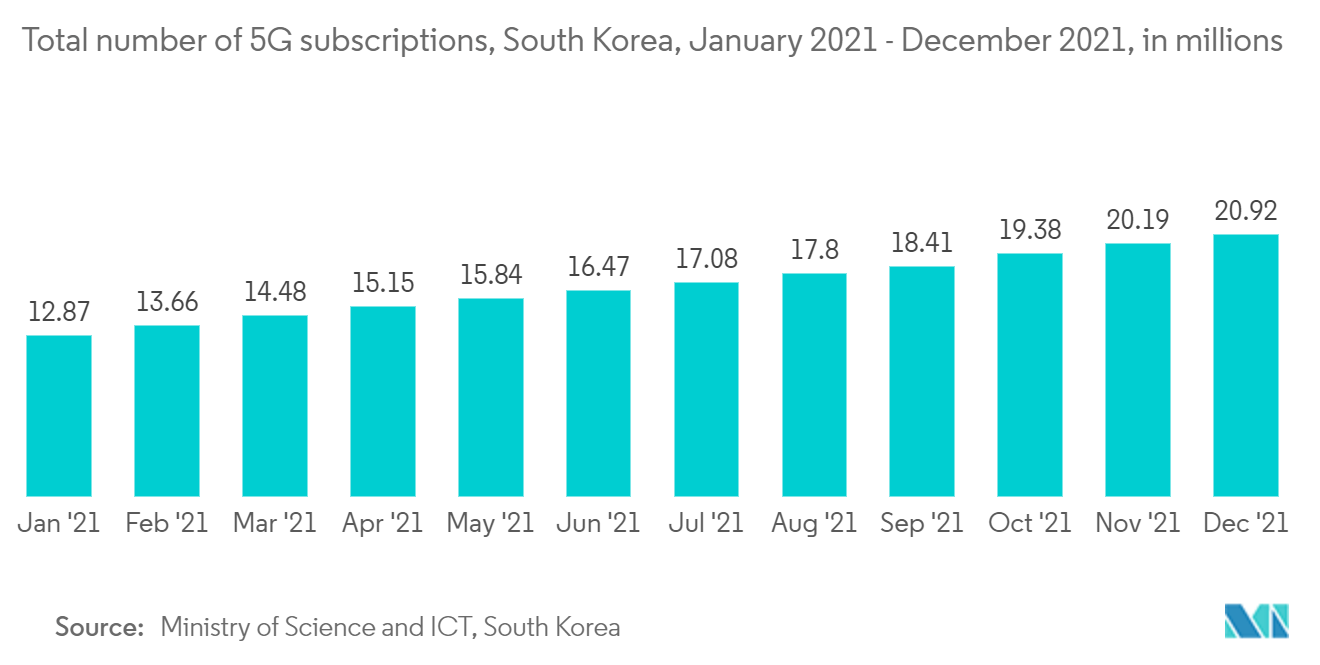
Steller OTT Services
- South Korea's media and entertainment sector is changing because of content digitization. The South Korean streaming market has had years of rapid expansion, and it is anticipated that this trend will continue. Even before COVID-19, platforms for streaming video were growing. However, COVID-19 dramatically expedited this tendency.
- Due to the globalization of K-pop, K-drama, and Korean culture, there is currently a great demand for Korean material.
- The Korean Film Council (KOFIC) reported in its annual report that Streaming Video on Demand (SVOD) platforms generated USD 58 million in total income in Korea in 2019. In contrast, the aggregate revenue in 2018 was USD 4 million. The figure for 2020 was estimated at USD 100 million. In South Korea, almost every customer has a smartphone. Therefore, any content is readily available to customers in the country. Thus, convenience drives the demand for OTT or SVOD programs. They desire simple content access so they can view it whenever they want, whenever they want, on any device.
- Moreover, there is a greater-than-ever demand in South Korea for video streaming services. The Korea Communications Commission estimates that the market for Korean video streaming is worth around USD 680 million. The over-the-top (OTT) market, which is another name for the streaming industry, encompasses all forms of media services and content made available to users directly online. Media platforms are no longer needed to go through cable providers, broadcasters, and TV networks. The amount of material consumed in Korea is significantly altering as a result, and major actors in the media sector are frantically trying to catch up.
- In South Korea, almost every customer has a smartphone. Therefore, any content is readily available to customers in the country. Thus, convenience drives the demand for OTT or SVOD programs. Consumers desire simple content access so they can view it whenever they want, whenever they want, on any device.
- The monthly rates for many SVOD services are inexpensive because many young people in Korea are switching to these SVOD services. It is far less expensive than seeing a movie in a Korean cinema, where admission plus refreshments may cost at least WON 30,000 (USD 21.14) per person. In Korea, several SVOD services provide high-quality original material.
- The majority of SVOD services in Korea adopt Netflix's marketing approach. This strategy includes producing original material. A growing amount of premium material that would have been distributed in cinemas is now immediately accessible on these channels. The Korean SVOD market is expected to grow much faster in the coming years.
- The most popular video streaming service in South Korea is Netflix. To deliver its content on LG's pay-TV service, Netflix teamed up with LG Uplus Corp. They were able to collaborate with telecom company KT Corp. so that they could provide their services on KT's pay-TV platform Olleh. As a result, Netflix is now available to Olleh TV customers. A combined 35% of Korea's pay-TV market is controlled by the two telecom carriers in South Korea. At present, Netflix has an estimated 9 million paying customers and the highest active user base among OTT providers in the country.
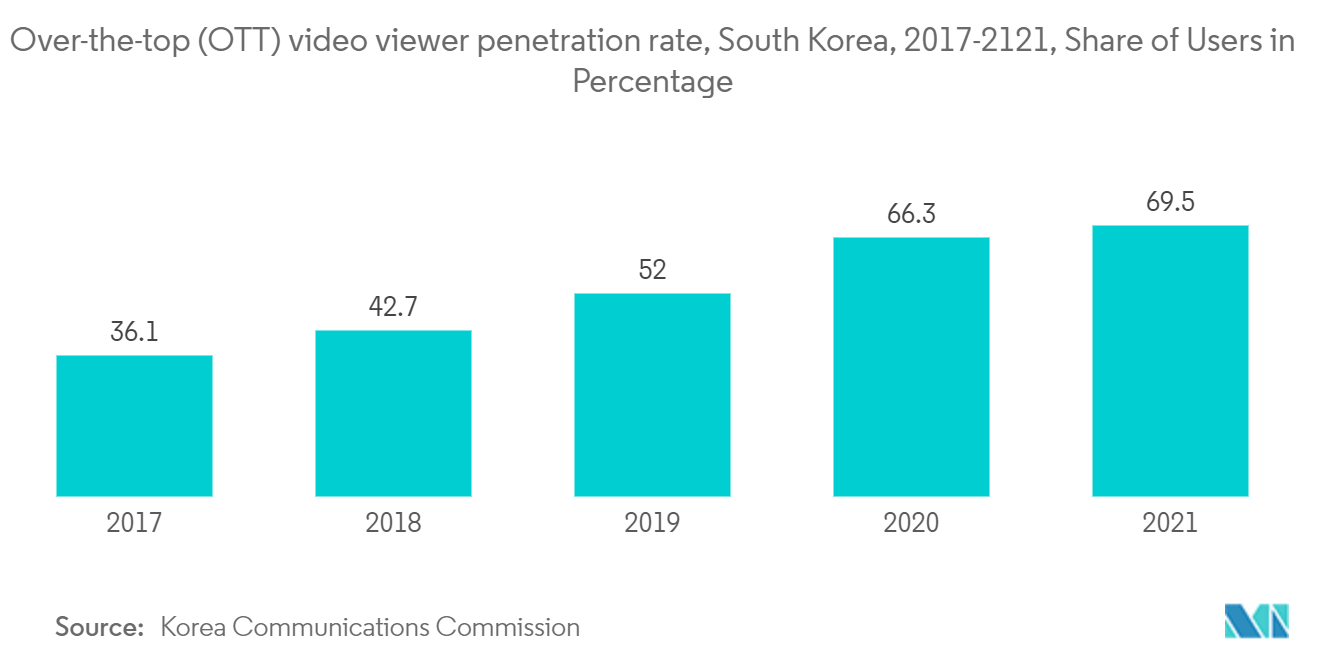
South Korea Telecom Industry Overview
The South Korean telecom market is moderately fragmented in nature. Some major players in the market studied include SK Telecom Co. Ltd, LG Uplus Corp., StarHub Limited, Korea Telecommunications Authority, Samsung Electronics Co. Ltd., and DASAN Network Solutions Inc. The market also hosts other internet service providers (ISPs), MVNOs, and fixed-line service providers. Some South Korean telecommunication companies are competitive internationally and hold firm ground in the global telecom space.
- In January 2022, SK Telecom, SK Square, and SK Hynix announced the "SK ICT Alliance" to jointly develop and engage in ICT convergence technologies and open international market potential. The partnership is announced as SK Hynix marks its tenth anniversary as a member of the SK Group. SK Square successfully separated from SK Telecom, ushering in a new age of synergies across semiconductors, telephony, and investment.
- In June 2022, Samsung Electronics and NAVER Cloud partnered to launch Korea's first private 5G network. With the aid of Samsung's personal 5G network solutions and NAVER's cloud technologies, the firms would collaborate to create new business models and use cases to extend private 5G networks internationally. This move is expected to promote the establishment of secure and devoted networks for businesses.
South Korea Telecom Market Leaders
-
SK Telecom Co., Ltd
-
LG Uplus Corp.
-
Korea Telecommunications Authority
-
Samsung Electronics Co., Ltd.
-
DASAN Network Solutions, Inc.
- *Disclaimer: Major Players sorted in no particular order
South Korea Telecom Market News
- In September 2022, StarHub confirmed that it had agreed with Yahoo to introduce a specific Premier League-focused subject center on Yahoo Singapore. The platform would have all the most recent news, results, analysis, and player moves during the 2022-2023 season, making it a one-stop shop for Premier League fans.
- In October 2022, LG Uplus, as part of its digital strategy, announced the launch of its new AI product offering. The new service is a component of the telco's long-term plan to become a supplier of digital platform services. According to the third largest telecom service provider in South Korea, the new AI service called "ixi" offers AI-powered services for small company administration, customer call centers, sports match predictions and content suggestions.
South Korea Telecom Industry Segmentation
Telecom or Telecommunication is the long-range transmission of information by electromagnetic means.
The study on the South Korean telecom market includes an in-depth trend analysis based on connectivity like Fixed Networks, Mobile Networks, and Telecom Towers. The telecom services are divided into Voice Services (Wired and Wireless), Data and Messaging Services, OTT, and PayTV Services. The adoption of telecom services is likely driven by several factors, including an increasing demand for 5G.
The market sizes and forecasts are provided in terms of value (USD million) for all the above segments.
| Segmentation by Services (Coverage to Include Average Revenue Per User for the Overall Services Segment, Market Size, Estimates for Each Segment, and In-depth Trend Analysis) | Voice Services | Wired |
| Wireless | ||
| Data and Messaging Services (Coverage to Include Internet and Handset Data Packages and Package Discounts) | ||
| OTT and Pay-TV Services |
South Korea Telecom Market Research FAQs
What is the current South Korea Telecom Market size?
The South Korea Telecom Market is projected to register a CAGR of 3.23% during the forecast period (2025-2030)
Who are the key players in South Korea Telecom Market?
SK Telecom Co., Ltd, LG Uplus Corp., Korea Telecommunications Authority, Samsung Electronics Co., Ltd. and DASAN Network Solutions, Inc. are the major companies operating in the South Korea Telecom Market.
What years does this South Korea Telecom Market cover?
The report covers the South Korea Telecom Market historical market size for years: 2019, 2020, 2021, 2022, 2023 and 2024. The report also forecasts the South Korea Telecom Market size for years: 2025, 2026, 2027, 2028, 2029 and 2030.
Our Best Selling Reports
Filter Integrity Test Industry Report
Statistics for the 2025 South Korea Telecom market share, size and revenue growth rate, created by Mordor Intelligence™ Industry Reports. South Korea Telecom analysis includes a market forecast outlook for 2025 to 2030 and historical overview. Get a sample of this industry analysis as a free report PDF download.

